Page 393 of 484
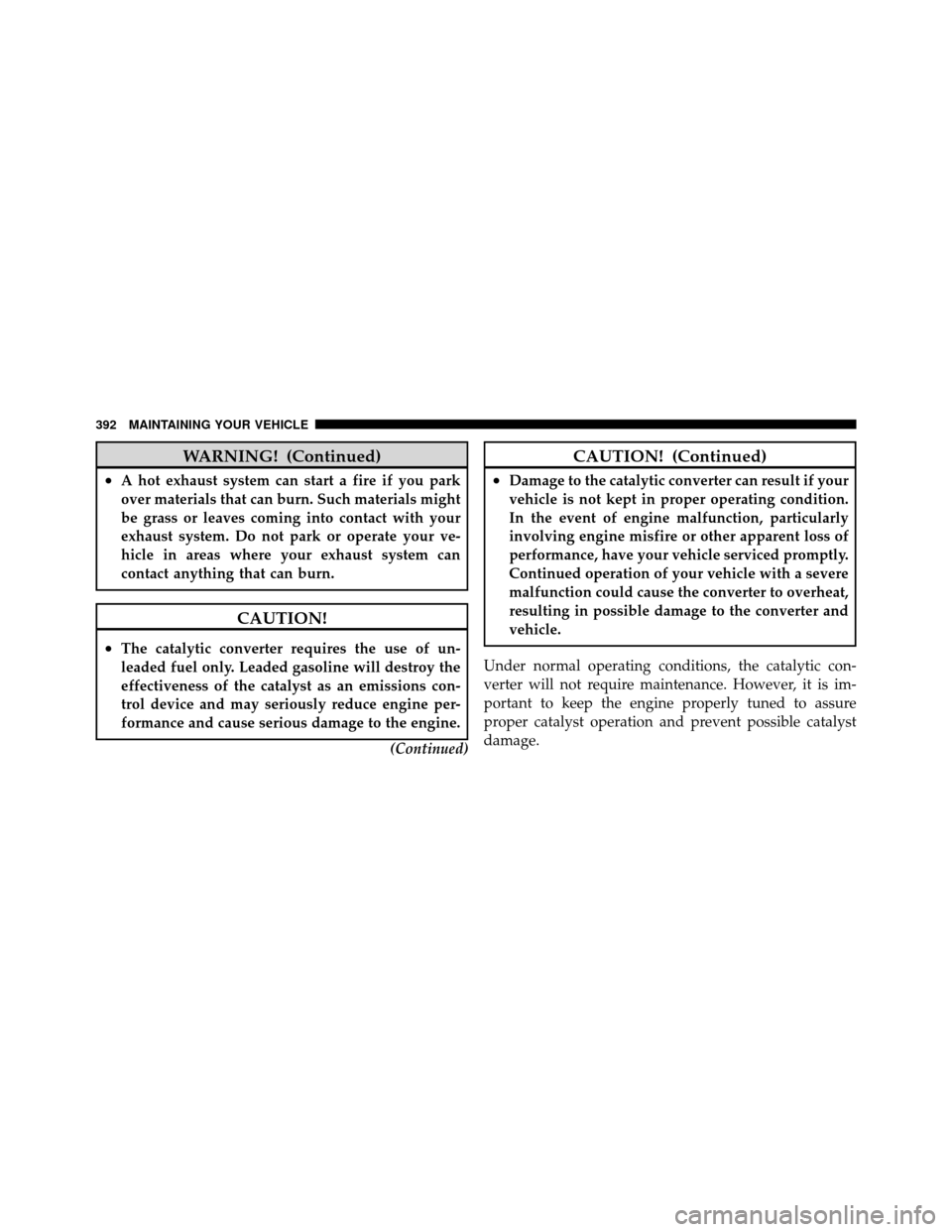
WARNING! (Continued)
•A hot exhaust system can start a fire if you park
over materials that can burn. Such materials might
be grass or leaves coming into contact with your
exhaust system. Do not park or operate your ve-
hicle in areas where your exhaust system can
contact anything that can burn.
CAUTION!
•The catalytic converter requires the use of un-
leaded fuel only. Leaded gasoline will destroy the
effectiveness of the catalyst as an emissions con-
trol device and may seriously reduce engine per-
formance and cause serious damage to the engine.(Continued)
CAUTION! (Continued)
•Damage to the catalytic converter can result if your
vehicle is not kept in proper operating condition.
In the event of engine malfunction, particularly
involving engine misfire or other apparent loss of
performance, have your vehicle serviced promptly.
Continued operation of your vehicle with a severe
malfunction could cause the converter to overheat,
resulting in possible damage to the converter and
vehicle.
Under normal operating conditions, the catalytic con-
verter will not require maintenance. However, it is im-
portant to keep the engine properly tuned to assure
proper catalyst operation and prevent possible catalyst
damage.
392 MAINTAINING YOUR VEHICLE
Page 394 of 484
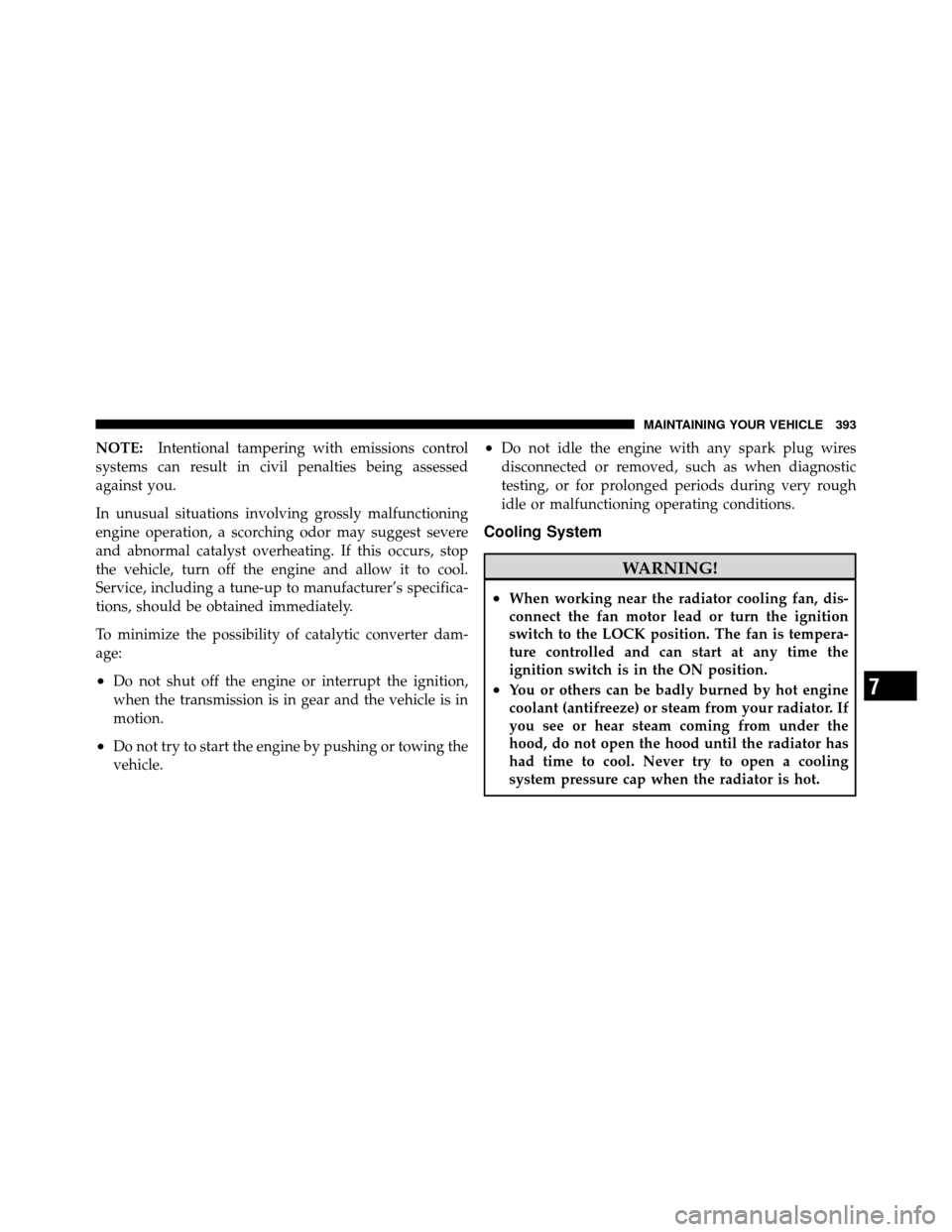
NOTE:Intentional tampering with emissions control
systems can result in civil penalties being assessed
against you.
In unusual situations involving grossly malfunctioning
engine operation, a scorching odor may suggest severe
and abnormal catalyst overheating. If this occurs, stop
the vehicle, turn off the engine and allow it to cool.
Service, including a tune-up to manufacturer’s specifica-
tions, should be obtained immediately.
To minimize the possibility of catalytic converter dam-
age:
•Do not shut off the engine or interrupt the ignition,
when the transmission is in gear and the vehicle is in
motion.
•Do not try to start the engine by pushing or towing the
vehicle.
•Do not idle the engine with any spark plug wires
disconnected or removed, such as when diagnostic
testing, or for prolonged periods during very rough
idle or malfunctioning operating conditions.
Cooling System
WARNING!
•When working near the radiator cooling fan, dis-
connect the fan motor lead or turn the ignition
switch to the LOCK position. The fan is tempera-
ture controlled and can start at any time the
ignition switch is in the ON position.
•You or others can be badly burned by hot engine
coolant (antifreeze) or steam from your radiator. If
you see or hear steam coming from under the
hood, do not open the hood until the radiator has
had time to cool. Never try to open a cooling
system pressure cap when the radiator is hot.7
MAINTAINING YOUR VEHICLE 393
Page 398 of 484
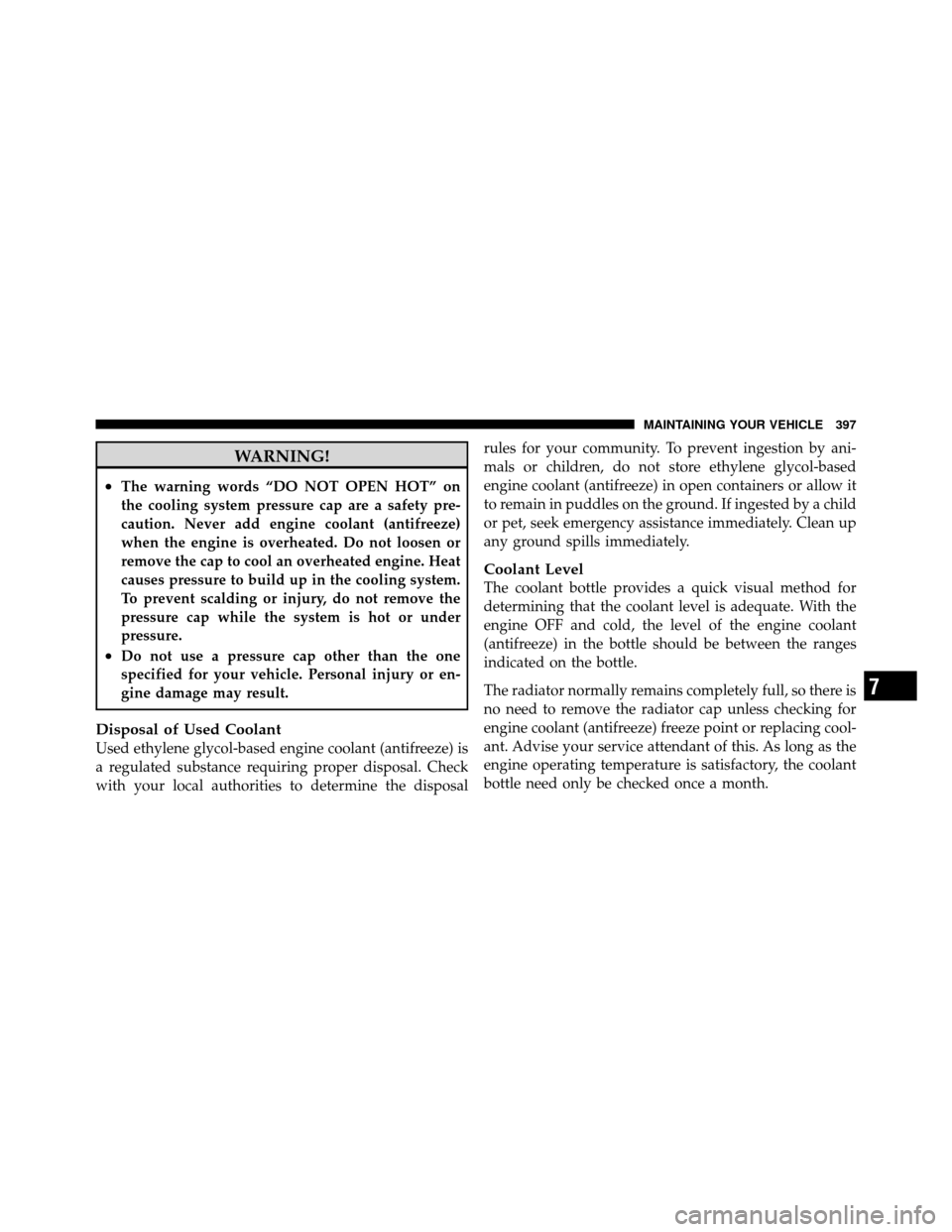
WARNING!
•The warning words “DO NOT OPEN HOT” on
the cooling system pressure cap are a safety pre-
caution. Never add engine coolant (antifreeze)
when the engine is overheated. Do not loosen or
remove the cap to cool an overheated engine. Heat
causes pressure to build up in the cooling system.
To prevent scalding or injury, do not remove the
pressure cap while the system is hot or under
pressure.
•Do not use a pressure cap other than the one
specified for your vehicle. Personal injury or en-
gine damage may result.
Disposal of Used Coolant
Used ethylene glycol-based engine coolant (antifreeze) is
a regulated substance requiring proper disposal. Check
with your local authorities to determine the disposalrules for your community. To prevent ingestion by ani-
mals or children, do not store ethylene glycol-based
engine coolant (antifreeze) in open containers or allow it
to remain in puddles on the ground. If ingested by a child
or pet, seek emergency assistance immediately. Clean up
any ground spills immediately.
Coolant Level
The coolant bottle provides a quick visual method for
determining that the coolant level is adequate. With the
engine OFF and cold, the level of the engine coolant
(antifreeze) in the bottle should be between the ranges
indicated on the bottle.
The radiator normally remains completely full, so there is
no need to remove the radiator cap unless checking for
engine coolant (antifreeze) freeze point or replacing cool-
ant. Advise your service attendant of this. As long as the
engine operating temperature is satisfactory, the coolant
bottle need only be checked once a month.
7
MAINTAINING YOUR VEHICLE 397
Page 468 of 484
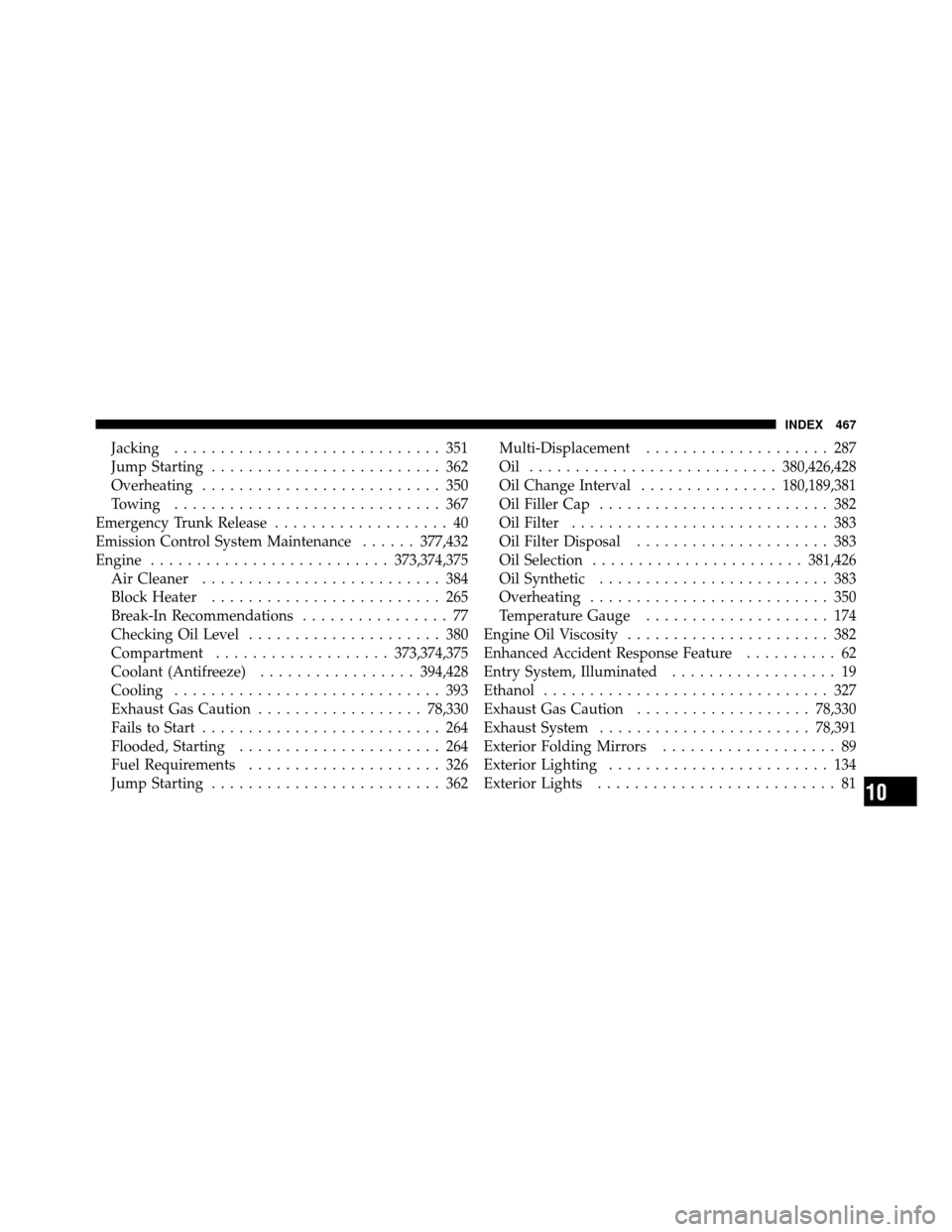
Jacking............................. 351
Jump Starting ......................... 362
Overheating .......................... 350
Towing ............................. 367
Emergency Trunk Release ................... 40
Emission Control System Maintenance ......377,432
Engine .......................... 373,374,375
Air Cleaner .......................... 384
Block Heater ......................... 265
Break-In Recommendations ................ 77
Checking Oil Level ..................... 380
Compartment ................... 373,374,375
Coolant (Antifreeze) ................. 394,428
Cooling ............................. 393
Exhaust Gas Caution .................. 78,330
Fails to Start .......................... 264
Flooded, Starting ...................... 264
Fuel Requirements ..................... 326
Jump Starting ......................... 362 Multi-Displacement
.................... 287
Oil ........................... 380,426,428
Oil Change Interval ...............180,189,381
Oil Filler Cap ......................... 382
Oil Filter ............................ 383
Oil Filter Disposal ..................... 383
Oil Selection ....................... 381,426
Oil Synthetic ......................... 383
Overheating .......................... 350
Temperature Gauge .................... 174
Engine Oil Viscosity ...................... 382
Enhanced Accident Response Feature .......... 62
Entry System, Illuminated .................. 19
Ethanol ............................... 327
Exhaust Gas Caution ................... 78,330
Exhaust System ....................... 78,391
Exterior Folding Mirrors ................... 89
Exterior Lighting ........................ 134
Exterior Lights .......................... 81
10
INDEX 467
Page 476 of 484
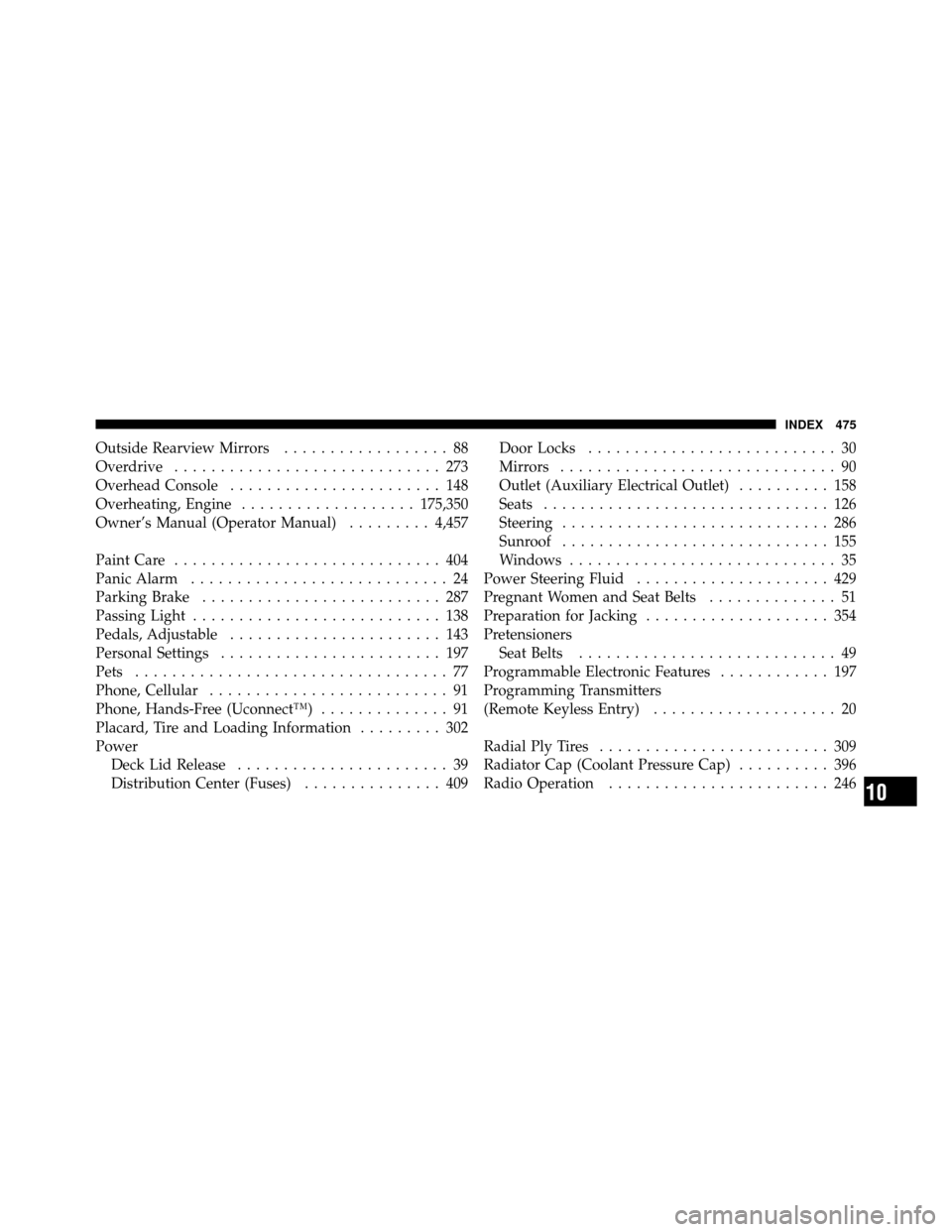
Outside Rearview Mirrors.................. 88
Overdrive ............................. 273
Overhead Console ....................... 148
Overheating, Engine ................... 175,350
Owner’s Manual (Operator Manual) .........4,457
Paint Care ............................. 404
Panic Alarm ............................ 24
Parking Brake .......................... 287
Passing Light ........................... 138
Pedals, Adjustable ....................... 143
Personal Settings ........................ 197
Pets .................................. 77
Phone, Cellular .......................... 91
Phone, Hands-Free (Uconnect™) .............. 91
Placard, Tire and Loading Information ......... 302
Power Deck Lid Release ....................... 39
Distribution Center (Fuses) ............... 409 Door Locks
........................... 30
Mirrors .............................. 90
Outlet (Auxiliary Electrical Outlet) .......... 158
Seats ............................... 126
Steering ............................. 286
Sunroof ............................. 155
Windows ............................. 35
Power Steering Fluid ..................... 429
Pregnant Women and Seat Belts .............. 51
Preparation for Jacking .................... 354
Pretensioners Seat Belts ............................ 49
Programmable Electronic Features ............ 197
Programming Transmitters
(Remote Keyless Entry) .................... 20
Radial Ply Tires ......................... 309
Radiator Cap (Coolant Pressure Cap) .......... 396
Radio Operation ........................ 246
10
INDEX 475